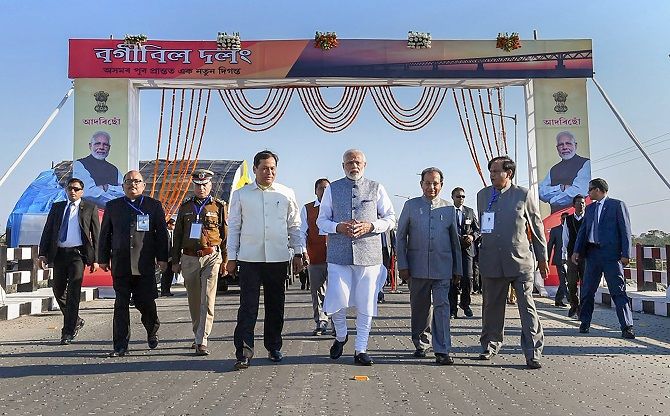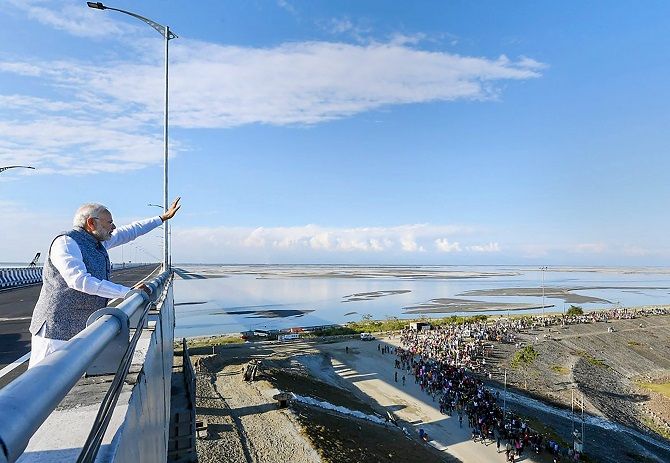In the event of a Chinese attack on Arunachal, troops and equipment from mainland India will travel on the existing south bank railway till Bogibeel, cross the Brahmaputra on the new bridge and then head further east on the Strategic Rail-Road Link, once it is ready.
Ajai Shukla reports.

On Tuesday, Prime Minister Narendra Damodardas Modi inaugurated the Rs 59.2-billion railway-road bridge at Bogibeel in Assam. It will link Dibrugarh, south of the Brahmaputra, with Dhemaji district on the north bank.
'The Bogibeel Bridge is a lifeline for the people of Assam. It has enhanced connectivity between Assam and other parts of the nation,' said Modi.
This is the fourth bridge over the Brahmaputra and has taken 33 years to build after it was promised as a part of the Assam Accord in 1985 -- an initiative directed towards improving the state's infrastructure.
It took 12 years for then prime minister H D Deve Gowda to lay its foundation stone in 1997, and another five years to start work, with then prime minister Atal Bihari Vajpayee inaugurating construction in 2002. The construction itself has taken 16 years.
Spanning 4.94 km in length, the Bogibeel Bridge caters to both rail and road traffic. It has two-way railway tracks on its lower level and a three-lane road on the upper level.
Another 73 km of new railway track will connect the existing trunk rail line on the Brahmaputra's so-called south bank with a new strategic railroad coming up on the north bank.
The new strategic infrastructure being built on the north bank is called the Strategic Rail-Road Link and will allow rail and road access to Upper Assam and eastern Arunachal Pradesh -- the northeastern tip of India.
In the event of a Chinese attack on Arunachal, troops and equipment from mainland India will travel on the existing south bank railway till Bogibeel, cross the Brahmaputra on the new bridge and then head further east on the Strategic Rail-Road Link, once it is ready.
The Indian Army sees the Bogibeel Bridge as "strategic infrastructure" that dramatically cuts rail travel time to the Dibang and Lohit river valleys in eastern Arunachal Pradesh.
"Earlier, military troops and equipment had to cross the Brahmaputra, and Arunachal rivers like the Lohit, only on barges and rafts. The nearest railway bridge at Guwahati was more than 400 km away, while Tezpur had only a road bridge. Now, trains can cross the Brahmaputra at Bogibeel and then travel further east on the new Strategic Link," explained a senior general.
Further, the Bogibeel Bridge allows troops located in Nagaland and Manipur to be rushed to the Sino-Indian border in Arunachal Pradesh much more quickly. Earlier, they had to cross the Brahmaputra either at Tezpur -- 250 km west -- or at the Dhola-Sadiya Bridge on the Lohit.
The mighty Brahmaputra, which can be up to 10 miles wide in many places, requiring a two-hour ferry ride to cross the river, divides Assam geographically, strategically, and culturally. The north bank and south bank developed separately, even their economies barely linked.
This changed only marginally in June 1963 when the Saraighat rail-road bridge first spanned the Brahmaputra at Guwahati. That bridge was inaugurated by Jawaharlal Nehru, after being completed on a war footing in the backdrop of the 1962 Sino-Indian conflict.
Almost a quarter century later in 1987, Rajiv Gandhi inaugurated the Kolia Bhomora road bridge at Tezpur. In 1988, Vajpayee inaugurated the third bridge over the Brahmaputra, a rail-road bridge in Lower Assam's Goalpara district.
Three bridges were also built over the Lohit River -- the Parshuram Kund Bridge at Wakro in 2006; the Lohit-Digaru Bridge at Alubari in 2017; and the Dhola-Sadiya Bridge the same year. The three Lohit bridges do not cater to rail traffic.
Modi took note of the endemic delays in construction, stating: 'Things have changed after May 2014, when topmost priority is being accorded to key projects.'

Manoj Jalan, who heads the Dibrugarh-headquartered Jalan Tea Estates Group, points out the need for more bridges linking the north bank and south bank.
"During the monsoons, the ferry sites often get washed away and cross-Brahmaputra movement comes to a halt. The people of Assam resent the fact that there are some 32-odd bridges across the Yamuna and just four across the Brahmaputra," he observes.
Thanks to the new rail connectivity over the Bogibeel Bridge, Modi also flagged off a new Tinsukia-Naharlagun Intercity Express, which will run five days a week. The Bogibeel Bridge will cut down the train travel time between Tinsukia to Naharlagun by more than 10 hours.











